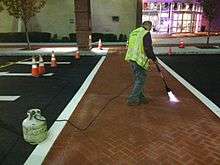Blowtorch
A blowtorch, is a fuel-burning tool used for applying flame and heat to various applications, usually metalworking.

Early blowtorches used liquid fuel, carried in a refillable reservoir attached to the lamp. Modern blowtorches are mostly gas-fuelled. Their fuel reservoir is disposable or refillable by exchange. Liquid-fuelled torches are pressurized by a piston hand pump, while gas torches are self-pressurized by the fuel evaporation.
Fuel torches are available in a vast range of size and output power. The term blowtorch applies to the smaller and lower temperature range of these. Blowtorches are typically a single hand-held unit, with their draught supplied by a natural draught of air. The larger torches may have a heavy fuel reservoir placed on the ground, connected by a hose. This is common for butane- or propane-fuelled gas torches, but also applies to the older, large liquid paraffin (kerosene) torches such as the Wells light.
Many torches now use a hose-supplied gas feed, which is often mains gas. They may also have a forced-air supply, from either an air blower or an oxygen cylinder. Both of these larger and more powerful designs are less commonly described as blowtorches, while the term blowtorch is usually reserved for the smaller and less powerful self-contained torches. The archaic term "blowpipe" is sometimes still used in relation to oxy-acetylene welding torches.
History
The blowtorch is of ancient origin and was used as a tool by goldsmiths and silversmiths. They began literally as a "blown lamp", a wick oil lamp with a mouth-blown tube alongside the flame. This type of lamp, with spirit fuel, continued to be in use for such small tasks into the late 20th century.
In 1797 or 1799, German inventor August von Marquardt invented a blowtorch in Eberswalde.
Another early blow pipe patent comes from USA, dated May 13, 1856.
In 1882, a new vaporizing technique was developed by Carl Richard Nyberg in Sweden, and the year after, the production of the Nyberg blowtorch started. It was quickly copied or licensed by many other manufacturers.
The US blowtorch was independently developed with a distinctive flared base and was fuelled by gasoline, whereas the European versions used kerosene for safety and low cost.
After the Korean War in the 1950s, propane caused many changes in the blowtorch industry worldwide, and by the 1970s most manufacturers of the old type of blowtorch, using gasoline or kerosene as fuel, had disappeared.[1] There remain several manufacturers producing brass blowtorches in India, China and North Korea for markets where propane gas is difficult to obtain or too expensive to be viable.
Applications
The blowtorch is commonly used where a diffuse (wide spread) high temperature naked flame heat is required but not so hot as to cause combustion or welding. Temperature applications are soldering, brazing, softening paint for removal, melting roof tar, or pre-heating large castings before welding such as for repairing. It is also common for use in weed control by controlled burn methods and melting snow and ice from pavements and driveways in cold climate areas. Especially the United States and Canada, road repair crews may use a blowtorch to heat asphalt or bitumen for repairing cracks in preventive maintenance. It is also used in cooking; one common use is for the creation of the layer of hard caramelized sugar in a crème brûlée.[2]
Types and variants
The blowtorch is referred to in industry and trade as per the fuel consumed by the tool:
- Gas:
- propane gas, see propane torch
- MAPP gas
- butane gas, see butane torch
- liquid petroleum gas (LPG) with ambient atmospheric air via a replaceable LPG cylinder.
- oxy-gas torch
- Liquid, with ambient atmospheric air after vaporizing it using a coiled tube passing through the flame. They take time to start, needing pre-heating with burning methylated spirit:
In the case of the gas torch the fuel tank often is small and serves also as the handle, and usually is refuelled by changing the fuel tank with the liquefied gas in it.
The forms with gaseous fuel are sometimes fed from a liquid petroleum gas cylinder via a hose.
Variants
A flame gun is a large type of blowlamp with built-in fuel tank, used for various purposes: weed control by controlled burn methods, melting snow and ice off walk and driveways in the winter, starting a fire, etc. It is commonly confused in word usage with a flamethrower.
Media
 A small butane torch
A small butane torch Handheld butane blowtorch
Handheld butane blowtorch Modern paraffin flame gun, 3 feet 3 inches = 1 m long
Modern paraffin flame gun, 3 feet 3 inches = 1 m long Handheld propane blowtorch
Handheld propane blowtorch Large propane torch used for construction
Large propane torch used for construction
References
- "History". Rusty Remakes. Archived from the original on 2014-05-21. Retrieved 21 May 2014.
- BBC - Food, Caramelising with a blowtorch.
External links
| Wikimedia Commons has media related to Blow torches. |
| Look up flame gun in Wiktionary, the free dictionary. |